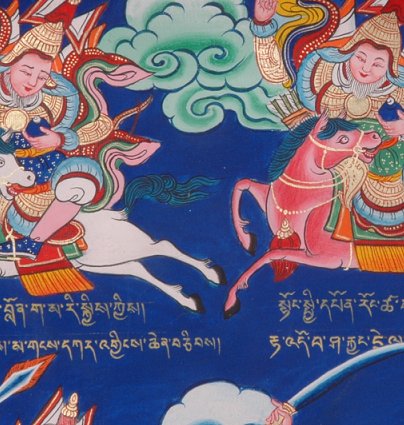Drala: Difference between revisions
No edit summary |
No edit summary |
||
| Line 1: | Line 1: | ||
[[Image:Dralas_from_gesar_wedding.jpg|frame|'''Image of Dralas from the ''Gesar Wedding Tonka'' by | [[Image:Dralas_from_gesar_wedding.jpg|frame|'''Image of Dralas from the ''Gesar Wedding Tonka'' by Gerry Haase''']] | ||
'''Drala''' (Tib. ''dgra bla'') or '''dralha''' (Tib. ''dgra lha'') - dynamically active non-human beings inhabiting the air element, who are usually invisible to ordinary human perception. They form the retinue and agents of [[Gesar]] and are usually portrayed as wild, fearless warriors on horseback. As [[Orgyen Tobgyal Rinpoche]] makes clear, the inner aspect of drala is connected to the subtle energy system in the body, and the ‘secret’ aspect to the nature of mind. | '''Drala''' (Tib. ''dgra bla'') or '''dralha''' (Tib. ''dgra lha'') - dynamically active non-human beings inhabiting the air element, who are usually invisible to ordinary human perception. They form the retinue and agents of [[Gesar]] and are usually portrayed as wild, fearless warriors on horseback. As [[Orgyen Tobgyal Rinpoche]] makes clear, the inner aspect of drala is connected to the subtle energy system in the body, and the ‘secret’ aspect to the nature of mind. | ||
Revision as of 21:16, 20 July 2007

Drala (Tib. dgra bla) or dralha (Tib. dgra lha) - dynamically active non-human beings inhabiting the air element, who are usually invisible to ordinary human perception. They form the retinue and agents of Gesar and are usually portrayed as wild, fearless warriors on horseback. As Orgyen Tobgyal Rinpoche makes clear, the inner aspect of drala is connected to the subtle energy system in the body, and the ‘secret’ aspect to the nature of mind.
Drala may be spelt two ways: ‘drala’ and ‘dralha’. These suggest two ways in which the inner aspect can be understood. ‘Drala’ connects it to la, one of the fundamental life-forces; so it can be seen as an aspect of our life-force which functions to protect us from our ‘enemies’. ‘Dralha’ connects it to lha, ‘deity’. This term should be understood to signify simultaneously both a natural force operating in the phenomenal world, and an aspect of our own pure awareness. Early spellings of the term suggest connections both with using sound to arouse la (which is perhaps one reason why windhorse practices are usually recited loudly), and with controlling the flow of prana in the channels.